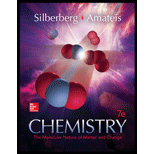
(a)
Interpretation:
The phase change when a diamond film forms on a surface from gaseous carbon atoms in a vacuum is to be determined.
Concept introduction:
The phase is defined as the physical state of a substance. The properties of a phase are determined by the interaction of the potential energy
1)
2) Liquid
3) Gas
When a solid phase is converted into a liquid phase and when a liquid freeze it changes to a solid phase. The phase changes can be expressed as follows:
When a liquid is vaporized it changes into the gaseous phase and when a gas condenses it converts to the liquid phase. The phase changes can be expressed as follows:
When gas is sublimed it changes directly to the solid phase and when a solid is deposited it converts directly to the gas phase. The phase changes can be expressed as follows:
(b)
Interpretation:
The phase change when mothballs in a bureau drawer disappear over time is to be determined.
Concept introduction:
The phase is defined as the physical state of a substance. The properties of a phase are determined by the interaction of the potential energy
1) Solid
2) Liquid
3) Gas
When a solid phase is converted into a liquid phase and when a liquid freeze it changes to a solid phase. The phase changes can be expressed as follows:
When a liquid is vaporized it changes into the gaseous phase and when a gas condenses it converts to the liquid phase. The phase changes can be expressed as follows:
When gas is sublimed it changes directly to the solid phase and when a solid is deposited it converts directly to the gas phase. The phase changes can be expressed as follows:
(c)
Interpretation:
The phase change when molten iron from a blast furnace is cast into ingots is to be determined.
Concept introduction:
The phase is defined as the physical state of a substance. The properties of a phase are determined by the interaction of the potential energy
1) Solid
2) Liquid
3) Gas
When a solid phase is converted into a liquid phase and when a liquid freeze it changes to a solid phase. The phase changes can be expressed as follows:
When a liquid is vaporized it changes into the gaseous phase and when a gas condenses it converts to the liquid phase. The phase changes can be expressed as follows:
When gas is sublimed it changes directly to the solid phase and when a solid is deposited it converts directly to the gas phase. The phase changes can be expressed as follows:
Trending nowThis is a popular solution!

Chapter 12 Solutions
Student Study Guide for Silberberg Chemistry: The Molecular Nature of Matter and Change
 ChemistryChemistryISBN:9781305957404Author:Steven S. Zumdahl, Susan A. Zumdahl, Donald J. DeCostePublisher:Cengage Learning
ChemistryChemistryISBN:9781305957404Author:Steven S. Zumdahl, Susan A. Zumdahl, Donald J. DeCostePublisher:Cengage Learning ChemistryChemistryISBN:9781259911156Author:Raymond Chang Dr., Jason Overby ProfessorPublisher:McGraw-Hill Education
ChemistryChemistryISBN:9781259911156Author:Raymond Chang Dr., Jason Overby ProfessorPublisher:McGraw-Hill Education Principles of Instrumental AnalysisChemistryISBN:9781305577213Author:Douglas A. Skoog, F. James Holler, Stanley R. CrouchPublisher:Cengage Learning
Principles of Instrumental AnalysisChemistryISBN:9781305577213Author:Douglas A. Skoog, F. James Holler, Stanley R. CrouchPublisher:Cengage Learning Organic ChemistryChemistryISBN:9780078021558Author:Janice Gorzynski Smith Dr.Publisher:McGraw-Hill Education
Organic ChemistryChemistryISBN:9780078021558Author:Janice Gorzynski Smith Dr.Publisher:McGraw-Hill Education Chemistry: Principles and ReactionsChemistryISBN:9781305079373Author:William L. Masterton, Cecile N. HurleyPublisher:Cengage Learning
Chemistry: Principles and ReactionsChemistryISBN:9781305079373Author:William L. Masterton, Cecile N. HurleyPublisher:Cengage Learning Elementary Principles of Chemical Processes, Bind...ChemistryISBN:9781118431221Author:Richard M. Felder, Ronald W. Rousseau, Lisa G. BullardPublisher:WILEY
Elementary Principles of Chemical Processes, Bind...ChemistryISBN:9781118431221Author:Richard M. Felder, Ronald W. Rousseau, Lisa G. BullardPublisher:WILEY





